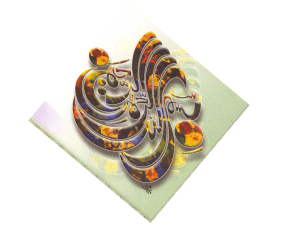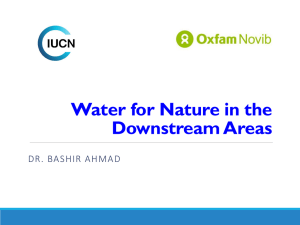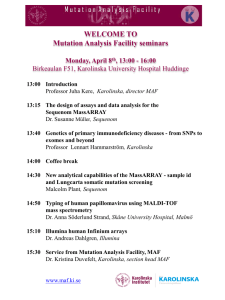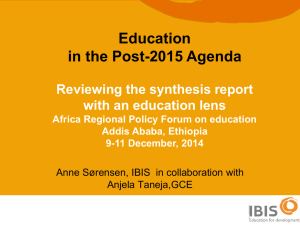MAF - University of Agriculture Faisalabad
advertisement
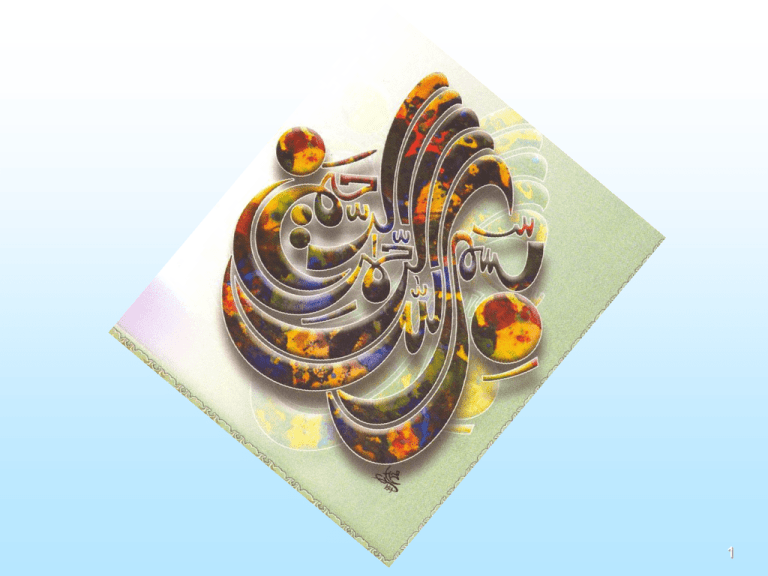
1 INDUS RIVER SYSTEM AUTHORITY (IRSA) “Water Apportionment Accord 1991, Indus River System Authority” January 10, 2011 University of Agriculture Faisalabad 2 The Water Agreements Indus Waters Treaty 1960 Water Apportionment Accord 1991 Inter-provincial Water Dispute The Inter-provincial dispute on Water Distribution was initiated during the construction of two mega Irrigation Projects i.e. Sutlej Valley Canal Project Sukkur Barrage 1932 1935 Committees / commissions 1937 Anderson Committee 1945 Rau Commission 1968 Akhtar Hussain Committee 1970 Fazal-e-Akbar Committee 1976 Indus Waters Commission (Anwar-ul-Haq Commission) 1983 Haleem Commission 1991 Water Accord Indus Tarbela Jhelum Mangla Kabul Chenab Ravi NWFP CRBC Sutlej C-J Chashma T-P Balochistan Canals Legend Sindh Barrages Punjab Barrages Reservoirs Major Rivers Rim Stations: Indus @ Tarbela Kabul @ Nowshera Jhelum @ Mangla Chenab @ Marala 6 6 ● Water Apportionment Accord (WAA) was signed amongst the Provinces on 16.03.1991 and approved by the Council of Common Interests (CCI) on 21.03.1991 ●Total Paras ●Paras on distribution ●Development Paras ●Escapages d/s Kotri ●Others 14 03 06 01 04 ● Under Clause 13 of the WAA ’91, the need to establish an Indus River System Authority was recognized and accepted for the implementation of the Accord. Contd..... 7 IRSA was established vide Act No. XXII of 1992 passed by the Parliament and approved by the President of Pakistan on, the 6th December 1992; One of the prime responsibilities of IRSA is the regulation and distribution of surface waters amongst the Provinces according to the allocation and policies spelt out in the Water Accord 1991; To Settle any question that may arise between two or more Provinces in respect of distribution of river and reservoir waters; Contd… 8 Any question in respect of implementation of Water Accord shall be settled by the Authority by the votes of the majority of members and in case of an equality of votes the Chairman shall have a casting vote ; A Provincial Government or the Water and Power Development Authority may, if aggrieved by any decision of the Authority, make a reference to the Council of Common Interests (CCI). 9 PROVISIONS OF WATER ACCORD 1991 PERTAINING TO DISTRIBUTION OF WATER 10 Para 14 (b) The record of actual average system uses for the period 1977-82, would form the guide line for developing a future regulation pattern. These ten daily uses would be adjusted pro-rata to correspond to the indicated seasonal allocations of the different canal systems and would form the basis for sharing shortages and surpluses on all Pakistan basis. 11 Para 14 (b) (MAF) Province MAF % Punjab 54.51 53.06 Sindh 43.53 42.37 Balochistan 1.63 1.59 KPK 3.06 2.98 Total 102.73 100.00 Para 2 In the light of the accepted water distributional principles, the following apportionment was agreed to: (MAF) Province Kharif Rabi Total Punjab 37.07 18.87 55.94 Sindh * 33.94 14.82 48.76 NWFP (a) 3.48 2.30 5.78 (b) Civil Canals ** 1.80 1.20 3.00 Balochistan 2.85 1.02 3.87 77.34 37.01 114.35 + + + 1.80 1.20 3.00 * Including already sanctioned Urban and Industrial uses for Metropolitan Karachi. ** Un-gauged Civil Canals above the rim stations. 13 Comparison of Para 2 vs Para 14 (b) (MAF) Para 2 Para 14 (b) Province Difference MAF % MAF % MAF (2-4) % 1 2 3 4 5 6 7 Punjab 55.94 48.92 54.51 53.06 1.43 12 Sindh 48.76 42.64 43.53 42.37 5.23 45 Baloch: 3.87 3.38 1.63 1.59 2.24 19 KPK 5.78 5.06 3.06 2.98 2.72 24 Total 114.35 100.00 102.73 100.00 11.62 100 Para 4 Balance river supplies (including flood supplies and future storages) shall be distributed as below: Punjab 37 Sindh 37 KPK 14 Balochistan Total % % % 12 % 100 % 15 Present Distribution Mechanism of IRSA (THREE TIER FORMULA SINCE 2003) Scenario I –Water Availability < Actual Average System Uses 77-82 –Distributed as per 14 (b) of the WAA 1991 Scenario II –Water Availability > Actual Average System Uses 77-82 but < Para 2 of WAA 1991 –Actual Average System Uses are protected –Balance available as per Para 2 i.e. 10-daily approved by CCI Scenario III –Water Availability > Para 2 of WAA 1991 –Para 2 i.e. 10-daily approved by CCI are protected –Balance as per Para 4 of the WAA 1991 Note: KPK & Balochistan are exempted from shortages 16 Para 6 The need for storages, wherever feasible on the Indus and other rivers was admitted and recognised by the participants for planned future agricultural development. 17 Western & Eastern Inflows & D/S Kotri Post Tarbela Average (1976.77 to 2009.10) (MAF) Max Min Avg Indus @ Kalabagh 112.18 66.81 89.71 Western Jhelum + Chenab 64.69 29.70 48.68 River Total 176.87 96.51 138.39 Ravi @ Balloki 10.95 0.29 4.23 Eastern Sutlej @ Sulemanki 10.62 0.01 2.59 River Total 21.57 0.30 6.82 Total Western & Eastern River 198.44 96.81 145.21 D/S Kotri 91.86 0.29 30.67 D/S Kotri (Apr 1, 2010 to Jan 6, 2011) 54.42 Provincial Canal Head Wdls (Post Independence to to-date) Year Canal Withdrawals (MAF) 1947 69.1 1965 88.4 1967-76 (Post-Mangla) 96.0 1977-82 (Post-Tarbela) 105.0 1990-1999 107.0 2000-2009 93.5 19 Reservoir Sedimentation (MAF) Designed Live Storage Present Live Storage Sedimentation % Tarbela 9.68 6.77 2.91 30 Mangla 5.34 *4.54 0.80 15 Chashma 0.77 0.263 0.51 66 Total 15.79 11.573 4.22 27 * Excluding raising component. After raising additional 2.99 MAF would be available 20 Historical vis-à-vis Present Peaks at Different Rivers/Barrages Since 1947 (Cs) Reservoir/ Barrage Designed Capacity Historical Peak /Year Present Peak /Date Remarks Tarbela 15,00,000 510,000 (89) 607,000/(30/07) Exceptional Nowshera 138,000 (06) 400,000 (30/07) Exceptional Attock 6,70,000 (58) 11,94,600 (30/07) Exceptional Kalabagh 9,50,000 8,62,000 (76) 9,36,000 (30/07) Exceptional Chashma 9,50,000 7,86,600 (76) 10,38,874 (1/8) Exceptional Taunsa 11,00,000 7,89,000 (58) 9,60,000 (2/8) Exceptional Guddu 12,00,000 11,99,672 (76) 11,48,200 (8/8) Exceptional Sukkur 15,00,000 11,66,574 (86) 11,24,720 (9/8) Exceptional Kotri 8,75,000 9,80,329 (56) 9,39,442 (27/8) Exceptional 21 Issues 22 Presently, due to sedimentation heavy shortages are being faced by the provinces during Late Rabi (March) as well as Early Kharif (Apr – Jun) periods (Creating provincial disharmony); Reservoirs normally touch the dead level in Late February & March (Critical period for Wheat maturity); Lean flows / erratic flows are being experienced in Early Kharif (Disturbing the sowing of Cotton Crops); The present storage component does not cater for the requirements of Existing Irrigation Infrastructure; Storage, as envisaged under Para 6 of the Accord, should be constructed on war footing basis; No feasible site at Chenab; Mangla has already been raised; Only Indus waters can be stored at different locations Contd… Period Hydel Thermal & Others 80’s 70 % 30 % 90’s to to-date 30 % 70 % Storages are required to reverse the 70 – 30 % ratio; Pakistan Hydel Generation Potential is 65,000 MW Storage for managing the floods; India total storage of 81 reservoirs is 151.77 BCM; (123 MAF) Indian Hydel Generation 37,000 MW (Potential 84044 MW) 25
